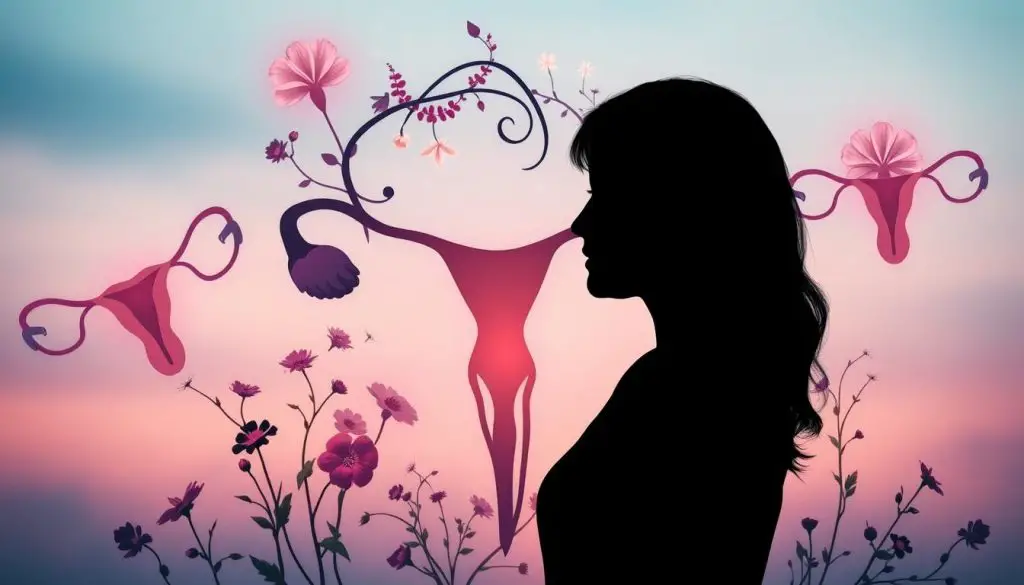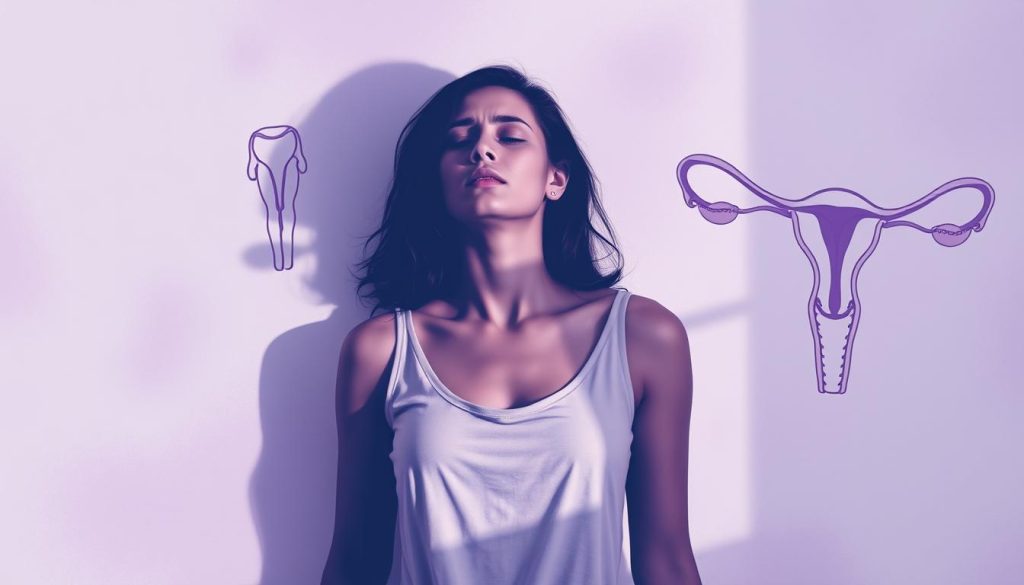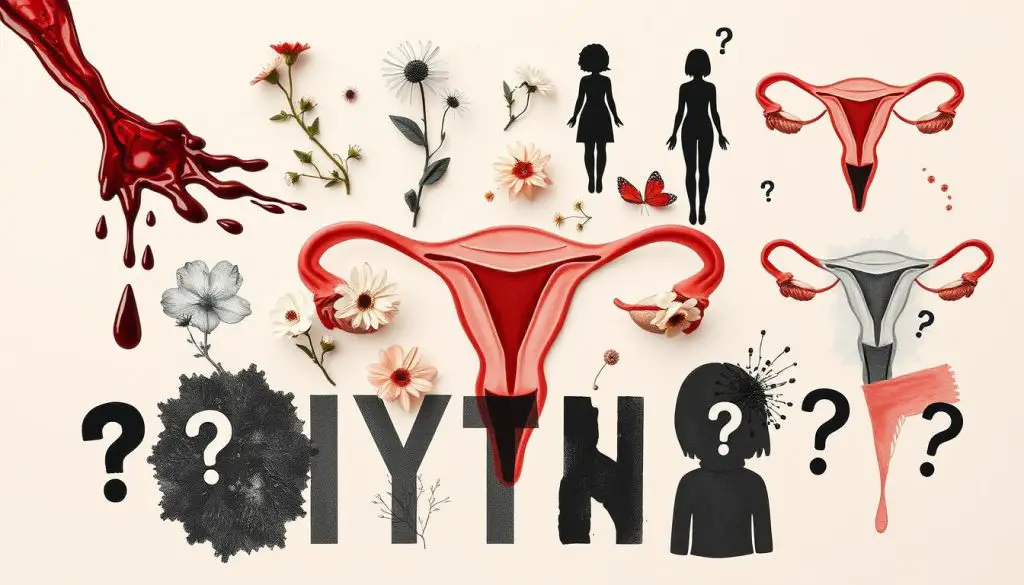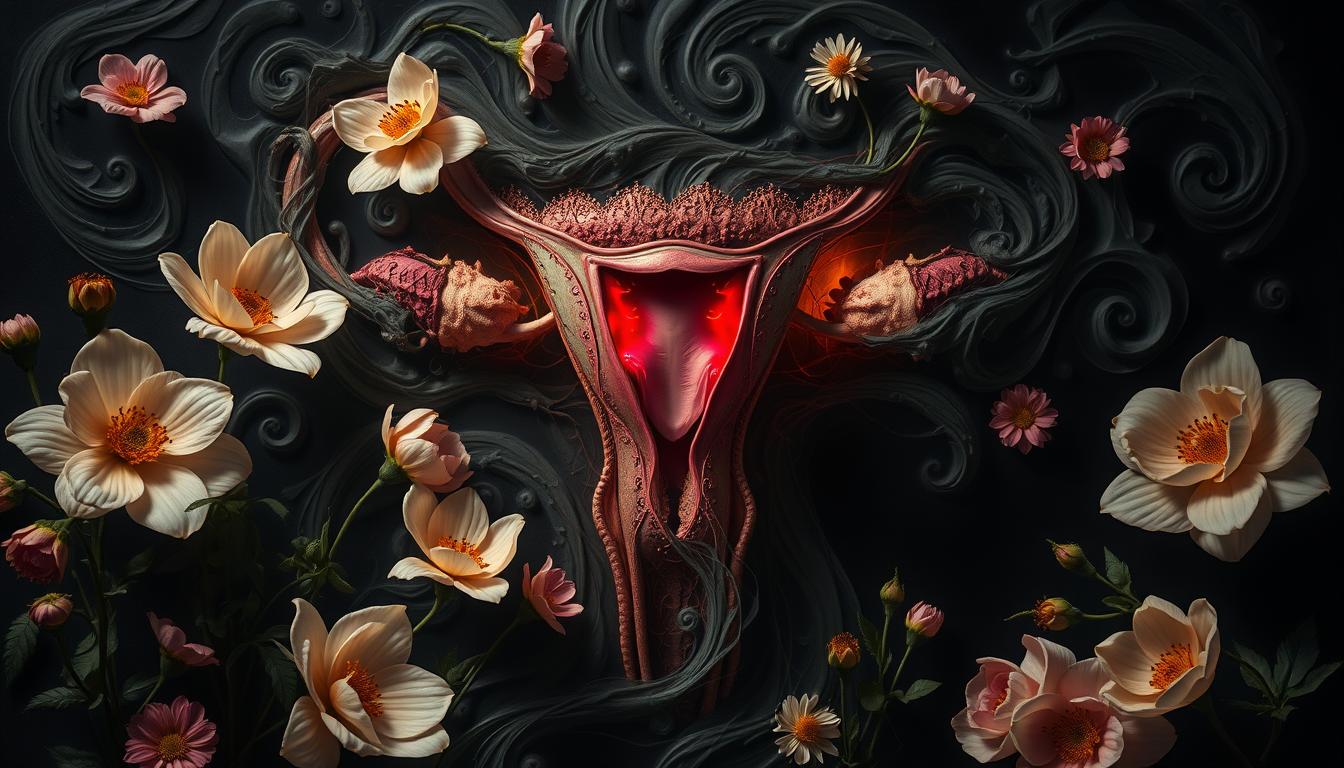If you’re among the millions of women dealing with heavy, painful periods, you might wonder if it’s endometriosis. This condition is marked by uterine-like tissue growing outside the uterus. Heavy menstrual bleeding is a key symptom. It’s vital to understand the connection between endometriosis and abnormal bleeding to get the right treatment.
Endometriosis affects about 1 in 10 women in the U.S. Worldwide, around 176 million women live with it. Many women face years of struggle before getting a correct diagnosis. This is often because heavy, painful periods are seen as normal or because of a lack of awareness about endometriosis.
If you have menstrual bleeding that lasts over a week, soaks through tampons or pads every hour, or is very painful, talk to your doctor. They can check if you might have endometriosis.
Does your heavy bleeding signala deeper issue? Learn about the link between endometriosis and abnormal uterine bleeding in this article.
What is Endometriosis?
Endometriosis is a chronic condition that affects 176 million women worldwide. It happens when tissue from the uterus grows on other pelvic organs. This includes the ovaries, fallopian tubes, bowel, and bladder.
Endometriosis Explained
This misplaced tissue reacts to hormones during the menstrual cycle. It leads to inflammation, scarring, and adhesions. These adhesions can cause organs to stick together, leading to pain and irregular periods.
Causes and Risk Factors
The exact cause of endometriosis is not known. But, some factors can increase the risk. These include:
- Early onset of menstruation (before age 12)
- Never having given birth
- A family history of endometriosis
- Menstrual cycles occurring more frequently than every 28 days
- Heavy and prolonged menstrual periods lasting longer than seven days
Endometriosis can greatly affect a person’s life. It can cause chronic pain, infertility, and other symptoms. Knowing about the condition and its risk factors is key to getting the right medical care.
Symptoms of Endometriosis
Endometriosis is a chronic condition that causes many symptoms. The main symptom is pelvic pain, which can be mild or very severe. This pain can happen during or outside of the menstrual cycle. It can also occur during intercourse, bowel movements, or urination.
Pelvic Pain and Discomfort
The pelvic pain from endometriosis is often the hardest symptom to deal with. This pain can get worse during menstruation, making daily activities hard. Some women also find painful intercourse to be a big problem, affecting their relationships and life quality.
Heavy Periods and Abnormal Bleeding
Another symptom is heavy, prolonged periods with a lot of bleeding and clotting. This heavy menstrual bleeding can cause anemia and more pain. Some people with endometriosis also have abnormal vaginal bleeding at times other than their regular period.
Other symptoms include fatigue, nausea, digestive problems, and trouble getting pregnant. Getting medical help quickly and working with healthcare providers is key to managing these symptoms.
Diagnosis of Endometriosis
Figuring out if you have endometriosis can be tricky. It often takes a mix of talking about your health, a physical check-up, and special imaging tests. At first, your doctor will want to know about your symptoms, health history, and family background. This helps them guess if you might have endometriosis.
Medical History and Physical Exam
The pelvic exam is a key part of finding out if you have endometriosis. Your doctor will look at your pelvic area to see if there are any unusual growths or scars. They might also do a bimanual exam. This means they’ll put a gloved finger in your vagina and press on your belly with their other hand.
Imaging Tests and Laparoscopy
If your doctor thinks you might have endometriosis, they might suggest more tests. These could be a transvaginal ultrasound or an MRI. These tests can show more about where and how big any endometriosis lesions are. But the best way to really know if you have endometriosis is through a laparoscopy. This surgery lets your doctor see inside your belly with a small camera.
| Diagnostic Approach | Description | Accuracy |
|---|---|---|
| Medical History and Physical Exam | Review of symptoms and pelvic examination | Limited, can suggest suspicion of endometriosis |
| Imaging Tests | Transvaginal ultrasound, MRI | Moderate, can detect some but not all endometriosis lesions |
| Laparoscopy | Surgical inspection of pelvic organs | Most accurate, considered the gold standard for diagnosis |
Finding out if you have endometriosis can take a long time. It often takes 7-9 years from when symptoms start to get a confirmed diagnosis. Getting a correct diagnosis quickly is very important for treating this chronic condition well.
Treatment Options for Endometriosis
Managing endometriosis often means using a mix of treatments. These include pain relief, hormone therapy, and sometimes surgery. The goal is to ease symptoms, slow down the growth of endometrial tissue, and in severe cases, remove it.
Pain Management
For pain, over-the-counter or prescription drugs like NSAIDs can help. These include ibuprofen for menstrual cramps and pelvic pain. They offer quick relief for many people.
Hormone Therapy
Hormone treatments, like birth control pills or GnRH agonists, can slow down endometrial growth. They change hormone levels to reduce symptoms. This can help control inflammation and pain.
Surgical Interventions
For severe cases, surgery might be needed. Laparoscopy is a common procedure to diagnose and treat endometriosis. It lets surgeons remove implants or adhesions. In some cases, removing the uterus might be considered for advanced endometriosis.
| Treatment | Description | Effectiveness |
|---|---|---|
| Pain Medication | Over-the-counter or prescription NSAIDs to alleviate pelvic pain | Provides temporary relief for many individuals |
| Hormone Therapy | Birth control pills, progestin-only medications, or GnRH agonists to suppress menstrual cycle and control endometrial growth | Can effectively manage symptoms, but not a permanent solution as symptoms may return after treatment cessation |
| Laparoscopic Surgery | Minimally invasive procedure to diagnose and remove endometrial implants or adhesions | Allows for assessment of the location, extent, and size of endometriosis growths, and can provide long-term relief for many patients |
| Hysterectomy | Surgical removal of the uterus, recommended for severe or debilitating cases of endometriosis | Can be an effective treatment option for individuals with advanced endometriosis, but is a major surgical procedure with potentially significant risks and complications |
heavy periods: A Common Symptom
Many women with endometriosis face heavy, long periods. The misplaced tissue outside the uterus reacts to hormones, causing abnormal bleeding. This can lead to periods lasting over seven days, needing frequent pad or tampon changes, or passing large clots.
Heavy menstrual bleeding, or menorrhagia, can be very tough. Some see it as needing to change sanitary products every hour for hours. Passing clots bigger than a quarter or bleeding for more than a week are also signs.
Age, hormonal imbalances, and growths in the uterus can cause abnormal bleeding. Even certain medications and conditions like fibroids can lead to too much flow. Teenagers often experience heavy bleeding due to not ovulating, which is common in the first years of menstruation.
Heavy periods can really affect a woman’s life, causing tiredness, anemia, and disrupting daily activities. It’s key to see a doctor, as it might show a health issue that needs treatment.
| Symptom | Indication |
|---|---|
| Soaking through one or more sanitary products every hour for several hours | Heavy menstrual bleeding |
| Passing blood clots larger than a quarter | Heavy menstrual bleeding |
| Bleeding for more than a week | Heavy menstrual bleeding |
If you’re dealing with heavy periods, menorrhagia, abnormal uterine bleeding, excessive menstrual flow, heavy menstrual bleeding, prolonged periods, or clotted menstrual blood, see a healthcare provider. They can find the cause and help find the right treatment.
Impact on Fertility
Endometriosis is a chronic and often painful condition. It can greatly affect a woman’s fertility. The growth of endometrial tissue outside the uterus can damage the ovaries and fallopian tubes. This makes it hard for a fertilized egg to implant in the uterus.
It’s estimated that endometriosis is a factor in up to 50% of female infertility cases. But, not all women with endometriosis face fertility issues. Many with mild endometriosis can conceive naturally. Treatments like laparoscopic surgery to remove endometrial implants can also help improve fertility.
It’s always best to talk to a healthcare professional. They can help you understand your situation and options.
| Condition | Impact on Fertility |
|---|---|
| Endometriosis | Up to 50% of female infertility cases |
| Uterine Fibroids | Can interfere with implantation or increase risk of miscarriage |
| Luteal Phase Deficiency | Reduced chances of becoming pregnant |
| Short Menstrual Cycles | Reduced fecundability (ability to conceive) |
If you’re having trouble getting pregnant, talk to your healthcare provider. They can help find the cause and discuss treatment options. With the right support and care, many women with endometriosis or other reproductive health conditions can achieve their fertility goals.

Coping with Endometriosis
Living with endometriosis can be tough, both physically and emotionally. But, there are ways to cope and find support. Joining a support group, online or in-person, is a great start. Here, you can meet others who get what you’re going through.
Support Groups and Resources
Support groups are a safe place to share and get support. You can learn tips and stay updated on treatments and research. There are also many organizations and online resources ready to help.
- Endometriosis Foundation of America
- Endometriosis Association
- Endometriosis UK
- Endometriosis Australia
- Endometriosis.org
Connecting with others who face the same challenges can be very helpful. You’ll find the support and advice you need. Remember, you’re not alone, and there’s help out there to improve your life.
Endometriosis and Menopause
Endometriosis can become more complex as women near menopause. Symptoms may get better or even go away after menopause. But, in some cases, symptoms can stay the same or even get worse. This is called post-menopausal endometriosis.
During menopause, hormonal changes can make symptoms better for many women. But, about 2 to 5 percent of women may keep experiencing symptoms even after menopause. This happens when leftover endometrial tissue keeps reacting to estrogen, even without regular periods.
Postmenopausal endometriosis is a unique challenge. Diagnosing and treating it can be different from the reproductive years. Doctors may use pelvic exams, imaging tests, and sometimes surgery to figure out how bad it is.
Treatment for post-menopausal endometriosis might include hormone therapy or surgery. Women with a history of endometriosis should keep in close touch with their doctors. This way, they can find the best ways to manage their condition during this time.
It’s key to know that endometriosis can stay or even get worse after menopause. Untreated, it can cause problems like tissue spreading, blockages, and higher cancer risks.

Women with endometriosis can manage menopause better by staying informed and proactive. This way, they can improve their quality of life.
Preventing Endometriosis
There’s no surefire way to stop endometriosis, but taking steps can slow it down. Birth control pills are a key strategy. They help control hormones and stop menstrual cycles, which slows endometrial tissue growth outside the uterus.
Early treatment of symptoms like heavy and painful periods is also important. Starting treatment in teens or young adults can lead to quicker diagnosis and treatment. This can lessen the condition’s long-term effects on quality of life.
Birth Control and Early Intervention
Birth control for endometriosis is a proven method for managing it. Hormonal birth control, like combination pills, controls symptoms. It does this by regulating the menstrual cycle and stopping endometrial tissue growth.
Also, early intervention for endometriosis is key. Treating symptoms like heavy, painful periods early can lead to quicker diagnosis and treatment. This can help avoid the serious long-term effects of endometriosis.
Using birth control for preventing endometriosis and starting treatment early can make a big difference. It’s a step towards managing this complex and often debilitating condition.
When to Seek Medical Attention
If you’re dealing with persistent or severe pelvic pain, heavy or long menstrual periods, or painful sex, see a doctor. Don’t think intense period symptoms are normal. Talking to your healthcare provider can lead to a diagnosis and treatment to help you feel better.
Some signs you should see a doctor for endometriosis include:
- Severe period cramps or pelvic pain that interferes with daily activities
- Abnormally heavy or prolonged menstrual bleeding, lasting more than 7 days
- Passing large blood clots during your period
- Painful intercourse or bowel movements
- Infertility or difficulty becoming pregnant
If you’re experiencing these symptoms of endometriosis, make an appointment with your healthcare provider. They will do a thorough check-up. This might include a physical exam, imaging tests, and possibly a laparoscopy to confirm the diagnosis. Early treatment is important to manage endometriosis and prevent it from getting worse.

Remember, heavy periods and severe symptoms are not something you have to endure. By talking to your doctor and working together, you can find a treatment plan. This will help alleviate your symptoms and improve your quality of life.
Endometriosis and Quality of Life
Endometriosis can deeply affect a woman’s life. It’s a chronic condition where uterine lining grows outside the uterus. This leads to severe symptoms that can disrupt daily life, relationships, and overall happiness. Studies have shown that endometriosis can significantly reduce a woman’s quality of life, physical and emotional health, and.
Common symptoms like severe pelvic pain, heavy and prolonged menstrual periods, and painful intercourse make everyday tasks hard. The chronic and unpredictable nature of these symptoms can cause stress, anxiety, and depression. This further affects a woman’s quality of life.
Endometriosis also impacts fertility, causing emotional distress. It’s linked to a higher risk of infertility, with approximately 30% prevalence of endometriosis reported in women of childbearing age with infertility.
Improving physical and mental health is key to bettering a woman’s life with endometriosis. Effective pain management, hormone therapy, and surgery can help with symptoms. Mental health support, like counseling and support groups, also helps manage emotional challenges.
| Impact of Endometriosis on Quality of Life | Percentage of Women Affected |
|---|---|
| Pelvic Pain | 92.5% |
| Dyspareunia (Pain During Intercourse) | 80.0% |
| Heavy Bleeding | 75.0% |
Healthcare providers and researchers are working to improve life for women with endometriosis. Ongoing research and new treatments offer hope for better management and support.
Ongoing Research and New Treatments
Endometriosis is a complex condition, but researchers are working hard to find new treatments. They are using advanced imaging and new therapies. This is bringing hope to those with this disorder.
One exciting area of endometriosis research is using new imaging technologies. Tools like 3D ultrasound and MRI are helping doctors see endometrial implants better. This gives them a clearer view of the condition.
Scientists are also looking into new endometriosis treatments. They are exploring stem cell therapy and targeted drug therapies. These could help regenerate tissue and reduce inflammation.
Surgical techniques are also getting better. New methods allow for more precise removal of endometrial implants. As we learn more, patients will have better treatment options.
While there’s much to learn, researchers’ dedication is giving hope. Their work is pushing the limits of science. This is changing lives for those with endometriosis.
Endometriosis Myths and Facts
There are many wrong ideas about endometriosis that can delay getting a diagnosis and treatment. It’s important to know the truth to help those affected. This way, we can provide the right care.
One myth is that endometriosis only hits women who are of childbearing age. But, research shows that up to 2-5% of women may have it even after menopause. So, endometriosis isn’t just for young women.
Another wrong idea is that heavy, painful periods are normal. But, studies reveal that over 60% of women with endometriosis have chronic pelvic pain. They are also 13 times more likely to have abdominal pain than those without it.
Many people think endometriosis is rare. But, about 10% of women of reproductive age worldwide have it. Knowing this can help us get them the help they need sooner.
It’s true that between 30 and 50 percent of women with endometriosis may struggle with infertility. But, this doesn’t mean all women with endometriosis will have trouble getting pregnant. The right treatment can help many women conceive.
By learning the real facts about endometriosis, we can improve how we diagnose, treat, and support those with this condition.

Common Endometriosis Misconceptions
- Endometriosis only affects women of reproductive age
- Heavy, painful periods are normal and not a sign of a problem
- Endometriosis is a rare condition
- Women with endometriosis cannot get pregnant
Endometriosis Facts
- Endometriosis can persist even after menopause
- Chronic pelvic pain and severe menstrual cramps are common symptoms of endometriosis
- Approximately 10% of females of reproductive age worldwide have endometriosis
- While endometriosis can impact fertility, many women with the condition are able to conceive with proper treatment
Endometriosis and Mental Health
Living with endometriosis can really affect a woman’s mental health. Studies show that women with endometriosis are more likely to feel depressed and anxious than others.
The pain, infertility, and other challenges of endometriosis can be tough. The stress and frustration of dealing with it can be overwhelming. It’s important for doctors to help with the emotional side of endometriosis too.
Research says nearly 1 in 10 people who menstruate have endometriosis. Also, roughly 4 in 10 women with infertility have endometriosis. These numbers show how common it is and its impact on mental health.
Women with endometriosis often feel more depressed or anxious. The chronic pain and other symptoms can make daily life hard. It can also affect social life and overall happiness.
Doctors need to focus on the emotional side of endometriosis, not just the physical. By helping patients find mental health support, they can improve their overall well-being.
Endometriosis in Adolescents
Endometriosis can start in the teenage years, even before many people know about it. Adolescents with endometriosis face severe menstrual cramps and heavy bleeding. These symptoms can really hurt their daily life and school.
Studies show that endometriosis in teens affects over 11% of girls in the U.S. between 15 and 44. Doctors have found it in 64% of teens with pelvic pain. This is a big problem.
It’s very important to catch endometriosis in adolescents early. This can help manage symptoms and prevent serious problems later. Doctors need to watch for signs of period issues in young patients. This can lead to quicker diagnosis and treatment for early onset endometriosis.
A study by Martire et al. in 2020 talked about how important adolescence is for endometriosis. They discussed symptoms, ultrasound signs, and the need for early diagnosis.
Dealing with endometriosis in adolescents often means using hormonal birth control and pain meds. Sometimes, surgery is needed if these don’t work. Making healthy lifestyle choices, like exercising and eating well, can also help with pain.
Source Links
- https://www.orlandohealth.com/content-hub/painful-long-heavy-periods-or-could-it-be-endometriosis/
- https://www.thewomens.org.au/health-information/periods/heavy-periods/what-causes-heavy-periods
- https://utswmed.org/conditions-treatments/heavy-bleeding-and-painful-periods/
- https://www.mayoclinic.org/diseases-conditions/endometriosis/symptoms-causes/syc-20354656
- https://medlineplus.gov/ency/article/000915.htm
- https://www.nhs.uk/conditions/endometriosis/
- https://www.nhsinform.scot/healthy-living/womens-health/girls-and-young-women-puberty-to-around-25/periods-and-menstrual-health/endometriosis/
- https://www.healthline.com/health/endometriosis/menorrhagia-and-endometriosis
- https://www.ncbi.nlm.nih.gov/pmc/articles/PMC8849430/
- https://www.who.int/news-room/fact-sheets/detail/endometriosis
- https://my.clevelandclinic.org/health/diseases/10857-endometriosis
- https://www.mayoclinic.org/diseases-conditions/endometriosis/diagnosis-treatment/drc-20354661
- https://www.hopkinsmedicine.org/health/conditions-and-diseases/endometriosis
- https://www.mayoclinic.org/diseases-conditions/menorrhagia/symptoms-causes/syc-20352829
- https://my.clevelandclinic.org/health/diseases/17734-menorrhagia-heavy-menstrual-bleeding
- https://www.cdc.gov/female-blood-disorders/about/heavy-menstrual-bleeding.html
- https://repromed.ie/fertility-hub/do-heavy-periods-affect-my-fertility
- https://www.parents.com/getting-pregnant/trying-to-conceive/how-your-period-affects-your-chances-of-getting-pregnant/
- https://www.bu.edu/sph/news/articles/2016/links-found-between-menstrual-cycle-characteristics-and-fertility/
- https://www.medicalnewstoday.com/articles/321402
- https://www.newhopefertility.com/blog/coping-with-endometriosis/
- https://www.balance-menopause.com/menopause-library/heavy-periods-during-the-perimenopause-what-you-need-to-know/
- https://www.healthline.com/health/womens-health/endometriosis-after-menopause
- https://www.drbozmd.com/blog/the-link-between-perimenopause-and-abnormal-bleeding
- https://www.brighamandwomens.org/obgyn/infertility-reproductive-surgery/endometriosis/medical-treatment-for-endometriosis
- https://www.mayoclinic.org/diseases-conditions/menorrhagia/diagnosis-treatment/drc-20352834
- https://www.healthline.com/health/womens-health/heavy-menstrual-bleeding-emergency
- https://www.medicalnewstoday.com/articles/what-will-er-do-for-heavy-menstrual-bleeding
- https://www.hopkinsmedicine.org/health/conditions-and-diseases/menorrhagia
- https://www.ncbi.nlm.nih.gov/pmc/articles/PMC10241351/
- https://www.ncbi.nlm.nih.gov/pmc/articles/PMC11121802/
- https://evidence.nihr.ac.uk/alert/the-coil-and-medicines-are-both-effective-long-term-treatments-for-heavy-periods/
- https://www.michiganmedicine.org/health-lab-podcast/new-research-launched-address-health-disparities-abnormal-menstrual-bleeding-and-anemia
- https://www.medicalnewstoday.com/articles/medical-myths-endometriosis-facts-vs-fiction
- https://www.riversideonline.com/patients-and-visitors/healthy-you-blog/blog/m/myths-and-facts-about-endometriosis
- https://medicine.yale.edu/news-article/women-with-endometriosis-also-genetically-predisposed-to-depression-anxiety-and-eating-disorders/
- https://www.ncbi.nlm.nih.gov/pmc/articles/PMC10465859/
- https://nyulangone.org/news/endometriosis-six-symptoms-you-should-never-ignore
- https://kidshealth.org/en/teens/endometriosis.html
- https://www.ncbi.nlm.nih.gov/pmc/articles/PMC10488856/
- https://www.medicalnewstoday.com/articles/endometriosis-in-teens
